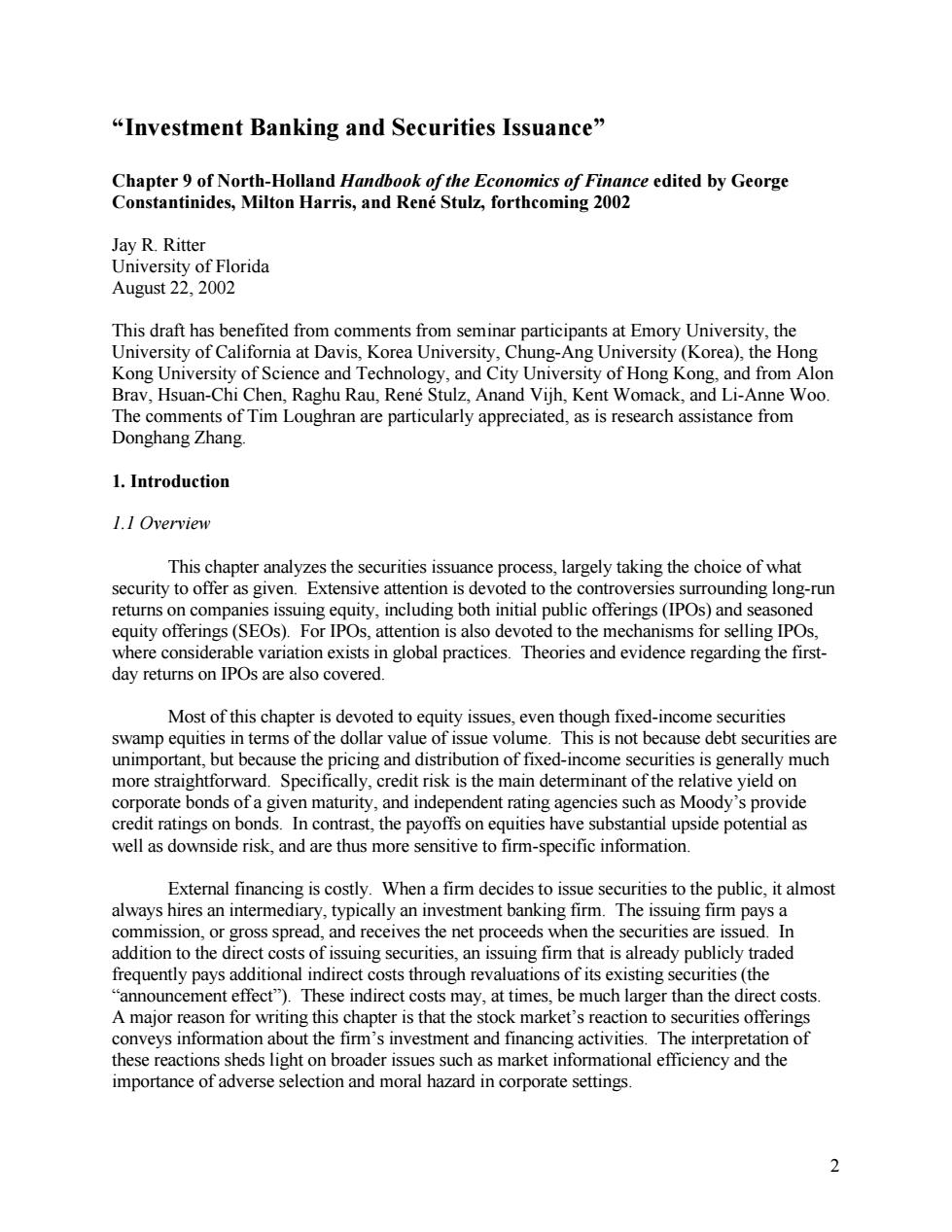正在加载图片...

"Investment Banking and Securities Issuance" Chapter 9 of North-Holland Handbook of the Economics of Finance edited by George Constantinides,Milton Harris,and Rene Stulz,forthcoming 2002 Jay R.Ritter University of Florida August 22,2002 This draft has benefited from comments from seminar participants at Emory University,the University of California at Davis,Korea University,Chung-Ang University (Korea),the Hong Kong University of Science and Technology,and City University of Hong Kong,and from Alon Brav,Hsuan-Chi Chen,Raghu Rau,Rene Stulz,Anand Vijh,Kent Womack,and Li-Anne Woo. The comments of Tim Loughran are particularly appreciated,as is research assistance from Donghang Zhang 1.Introduction 1.1 Overview This chapter analyzes the securities issuance process,largely taking the choice of what security to offer as given.Extensive attention is devoted to the controversies surrounding long-run returns on companies issuing equity,including both initial public offerings(IPOs)and seasoned equity offerings(SEOs).For IPOs,attention is also devoted to the mechanisms for selling IPOs, where considerable variation exists in global practices.Theories and evidence regarding the first- day returns on IPOs are also covered. Most of this chapter is devoted to equity issues,even though fixed-income securities swamp equities in terms of the dollar value of issue volume.This is not because debt securities are unimportant,but because the pricing and distribution of fixed-income securities is generally much more straightforward.Specifically,credit risk is the main determinant of the relative yield on corporate bonds of a given maturity,and independent rating agencies such as Moody's provide credit ratings on bonds.In contrast,the payoffs on equities have substantial upside potential as well as downside risk,and are thus more sensitive to firm-specific information. External financing is costly.When a firm decides to issue securities to the public,it almost always hires an intermediary,typically an investment banking firm.The issuing firm pays a commission,or gross spread,and receives the net proceeds when the securities are issued.In addition to the direct costs of issuing securities,an issuing firm that is already publicly traded frequently pays additional indirect costs through revaluations of its existing securities(the "announcement effect").These indirect costs may,at times,be much larger than the direct costs. A major reason for writing this chapter is that the stock market's reaction to securities offerings conveys information about the firm's investment and financing activities.The interpretation of these reactions sheds light on broader issues such as market informational efficiency and the importance of adverse selection and moral hazard in corporate settings. 22 “Investment Banking and Securities Issuance” Chapter 9 of North-Holland Handbook of the Economics of Finance edited by George Constantinides, Milton Harris, and René Stulz, forthcoming 2002 Jay R. Ritter University of Florida August 22, 2002 This draft has benefited from comments from seminar participants at Emory University, the University of California at Davis, Korea University, Chung-Ang University (Korea), the Hong Kong University of Science and Technology, and City University of Hong Kong, and from Alon Brav, Hsuan-Chi Chen, Raghu Rau, René Stulz, Anand Vijh, Kent Womack, and Li-Anne Woo. The comments of Tim Loughran are particularly appreciated, as is research assistance from Donghang Zhang. 1. Introduction 1.1 Overview This chapter analyzes the securities issuance process, largely taking the choice of what security to offer as given. Extensive attention is devoted to the controversies surrounding long-run returns on companies issuing equity, including both initial public offerings (IPOs) and seasoned equity offerings (SEOs). For IPOs, attention is also devoted to the mechanisms for selling IPOs, where considerable variation exists in global practices. Theories and evidence regarding the firstday returns on IPOs are also covered. Most of this chapter is devoted to equity issues, even though fixed-income securities swamp equities in terms of the dollar value of issue volume. This is not because debt securities are unimportant, but because the pricing and distribution of fixed-income securities is generally much more straightforward. Specifically, credit risk is the main determinant of the relative yield on corporate bonds of a given maturity, and independent rating agencies such as Moody’s provide credit ratings on bonds. In contrast, the payoffs on equities have substantial upside potential as well as downside risk, and are thus more sensitive to firm-specific information. External financing is costly. When a firm decides to issue securities to the public, it almost always hires an intermediary, typically an investment banking firm. The issuing firm pays a commission, or gross spread, and receives the net proceeds when the securities are issued. In addition to the direct costs of issuing securities, an issuing firm that is already publicly traded frequently pays additional indirect costs through revaluations of its existing securities (the “announcement effect”). These indirect costs may, at times, be much larger than the direct costs. A major reason for writing this chapter is that the stock market’s reaction to securities offerings conveys information about the firm’s investment and financing activities. The interpretation of these reactions sheds light on broader issues such as market informational efficiency and the importance of adverse selection and moral hazard in corporate settings